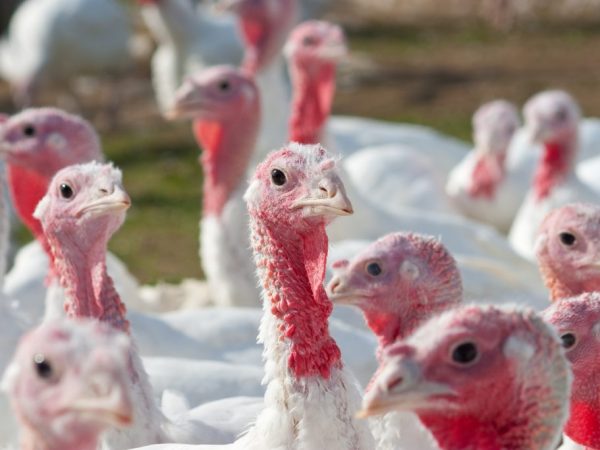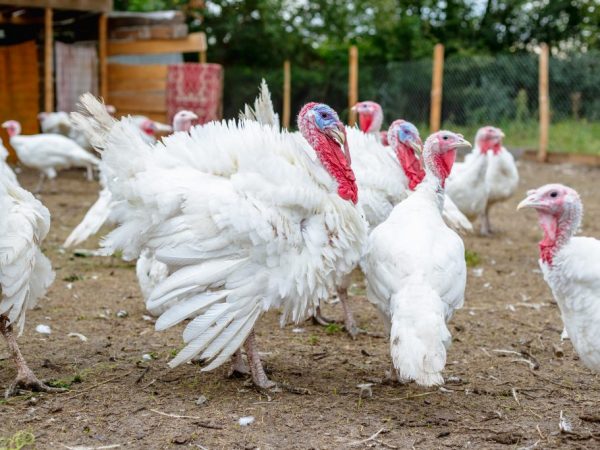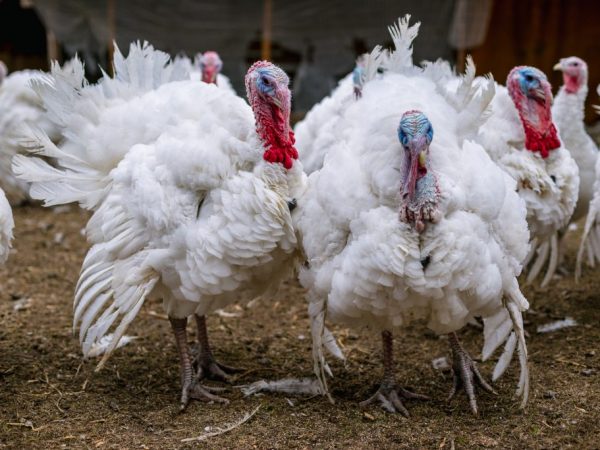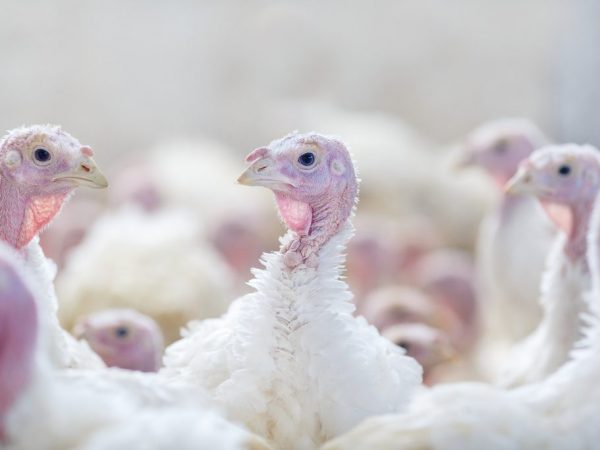Correct breeding of turkeys at home
Breeding turkeys is a fairly popular type of profitable business at home. Turkeys are very interesting for nature lovers. The turkey is a rather large bird, beautiful and strict at the same time. Turkeys live in a group where each member of the herd knows his place. The head of the turkey family is the male - the largest and most aggressive. Caring for turkeys at home is simple. Turkeys and their breeding at home, like geese, can be carried out at their summer cottage, where it is recommended to build a special poultry house for them.

Correct breeding of turkeys at home
In this case, all problems in the first weeks of life can be avoided. Before deciding on breeding turkeys and what kind of farm will be, you should familiarize yourself in detail with possible breeds, are they capricious, are there any difficulties in growing such birds, see photos and videos. In order to fully breed birds, you need to understand whether it is profitable or not, how much money will be required if you decide do business.
Advantages and disadvantages of turkey breeding
Turkeys and their features are that the bird is very useful in the economy, from them you can get not only meatbut also eggs. Both products are considered dietary. There is very little cholesterol in meat. It is ideal for those who are not advised by doctors to eat too fatty foods. Eggs of turkeys do not cause allergies, they are easily processed by the body. Therefore, they are recommended for pregnant women, young children and the sick. They contain a lot of nutrients, so athletes often include turkey eggs in their menu.
According to their benefits, they go right after the eggs quail and guinea fowl.
Turkeys have the following characteristics: they produce approximately 100 eggs from one bird per year, and one chicken produces an average of 340 eggs. In this regard, they are less profitable. But if we compare the meat of turkey, chicken and chicken meat at the market price, it turns out that the problems in economic terms, even in the first weeks or months, are insignificant. Yes, and meat from one turkey turns out more, you just have to compare their size. If you calculate all the factors, then problems in the first weeks can be avoided and breeding turkeys on a farm is far from unprofitable.
Popular bird species
The top species for breeding turkeys at home is the North Caucasian bronze. They look very beautiful because of the plumage, which is cast in bronze. Their body is elongated, and the chest is relatively small in size. The birds are very active, have long legs, and can find the necessary food themselves. An adult male weighs 13-18 kg, a female 7-8 kg. The owner does not lose by choosing an egg-laying breed. From one female, you can get 80-100 eggs per year. Popular with farmers and white broad-breasted turkey... Keeping turkeys at home of this breed requires skills and certain knowledge from the farmer.
The female begins to lay eggs at about 9 months of age. From one female you can get from 115 to 125 eggs per year. This type of turkey is also common, such as bronze broad-chested... This is the most resistant breed, which does not really require ideal keeping conditions. It is also distinguished by a very high fertility (almost 100%), which makes it convenient for breeding. Turkeys weigh about 18 kg, turkeys - about 10 kg. Sometimes the Moscow breed is also bred. It is divided into two subspecies: bronze and white. For birds of this species, the characteristic feature is a very strong body. The breed is also renowned for its fertility.
Poultry house

Warm turkey poultry is required
Modern breeds in our country have adapted to the cold, but it is worth considering that a warm room with low air humidity is better suited for their development. Caring for turkey poults includes the selection of the optimal temperature regime. Turkeys and their breeding and maintenance in summer is carried out at a temperature of 20 degrees, and in winter at least 5 degrees. Indoors, when caring for small individuals, drafts and excess moisture are avoided. Often turkeys bred in barnswhere chickens used to be kept. The option is quite acceptable, only the room needs to be rebuilt a little, since the size of the turkeys is larger, and of course, disinfection must be carried out.
Arrangement and maintenance of all turkeys in a room for 10 individuals
Turkeys, their care and maintenance should be planned in advance, therefore, approximate calculations are given, using them, you can calculate the size of living space for any number of this bird. The premise is built at the rate of 0.5-1 meters squared for 1 bird. Better to have more area. However, if conditions do not allow, then you can limit yourself to 50 square centimeters. Therefore, for 10 birds, an area of at least 5 square meters is required to breed a full-fledged breed.
The poultry house needs to be installed with ventilation, or another device to eliminate excess moisture. A mat should be placed on the floor to maintain the optimum temperature. It is best made from straw, although other materials can be used. It is completely replaced after 3-4 days. The perches are located at a height of 70 to 80 cm, the width of the slats is 5-7 cm. The slats must be strong, since the turkeys weigh a lot. One individual requires at least 40 cm of plank. If the birds are kept indoors, then lighting should also be considered.
The owner just needs to screw in a 60W bulb. It is no secret that parasites are often found in the feathers of poultry. Birds get rid of them by bathing in the dust. To do this, in the barn, you also need to take a place that is equipped with boxes where ash or sand is poured. Turkeys are very active, so it is advisable to come up with a place for them to walk. This is especially true in the summer. The plot is arranged at least 1 meter squared for 1 bird.
Arrangement of a walking area for turkeys
Part of the territory must be covered from above. Under a canopy, turkeys will take shelter in the summer heat. It is advisable that there is a green meadow with grass on the walking area, then divorce will become easier for both novice farmers and the individuals themselves. You can even specially plant forage crops such as oats, clover, and alfalfa in the spring. Don't forget about water, especially in summer. It should be fresh and change every day. If the water gets dirty often, then it should be changed more often than this period.
Feeders should also be placed on the site. It is better to put food there, which will not spoil soon, oats or barley. It is necessary to walk the bird not only in summer, but also in the cold season. True, it is worth remembering that when the frost is over 10 degrees, it is better for the bird to sit at home so that there are no colds, hypothermia and frostbite. It is best for the turkeys to step on straw instead of snow when walking, otherwise they may freeze their feet. Walking is necessary for such active birds, or their muscles will be too weak, and their meat will be too fat.
Many experienced breeders recommend that novice farmers keep females and males separately. It is believed that this is how males are less aggressive. With this content, one male is allowed to the females in the poultry house. However, keeping birds of different sexes and together is acceptable. It should be borne in mind that one turkey can fertilize no more than 5 turkeys. So there should be 5 times more females than males. If there are too many birds in one house, it is better to divide the turkeys into several families.
Growing turkeys during puberty

Vitamins in the diet are essential
The age when juveniles become adults in turkeys occurs at 8-10 months. It is at this time that the bird needs full development, which is impossible without healthy food rich in nutrients.
Standard feed composition
- Sprouted grain - 100 gr.
- Curd mass - 20 gr.
- Yeast - 5 gr.
- Greens and vegetables - 70-80 gr. Of vegetables, carrots are preferable.
Turkeys begin to lay eggs at 10 months of age. These birds are very good mothers, so turkeys must be chased to collect eggs. They strive to arrange a nest and hatch offspring from the laid eggs. This behavior of the bird is called “brood hen syndrome”. During the period when turkeys are laying eggs, it is especially important to provide them with the right food. Food is given to mothers 5 times a day. In winter, carrots, grass flour, moistened grain should be introduced into the diet of individuals that lay eggs. After a turkey has mated with a turkey, it begins to lay.
During the period of laying eggs, the turkey carries them up to 17 pieces. After that, the eggs should be checked for suitability. To find out if they have fertilized, you need to immerse them in water. If the egg has surfaced, then it must be placed in the nest. If the egg drowns, then it is only good for food. A turkey incubates eggs for 28 days. At this time, it is very important for the expectant mother to eat right. Moistened sprouted oats will be useful for her. When the bird eats, the eggs must not cool down, otherwise the chicks will die. It is best to cover them with a warm cloth. One turkey can hatch and raise 75-80 chicks. To do this, the female should lay eggs from other turkeys.
Young growth care
The main thing that newborn turkeys need is warmth. If this condition is not met in caring for small turkeys, then the bird begins to suffer from various diseases, and as a result, it may die. Even if such a disaster does not occur, the weight of the bird will be less than expected. In this case, even a good feeding will not affect the rapid weight gain. Contains turkey poults in a box or wooden box.
It is worth noting that if the cardboard gets wet, then unreasonable chicks can begin to peck at it, and this is not useful for still fragile stomachs. It is better to lay a cloth, sawdust on the bottom. The size of the box must be at least a square meter. The walls must be at least 40 centimeters, or too curious chicks can escape. An electric lamp should be mounted above the box with juveniles. The desktop can also be upgraded for this purpose. She will give the kids light and warmth. The power of the lighting device must be at least 40 watts.
If the room is too cool, then you can mount the lamps in a box. Just make sure that it is reliably isolated, otherwise the poults may burn themselves. It is not advisable to turn off the light of the bird for the first two days. Later, the light setting should be reduced. This is done gradually. Time is reduced by 35-30 minutes per day. When the turkey poults are 20 days old, the light can be turned on for 15 hours every day. The temperature regime should also be gradually made cooler. In newborns in their home, the temperature should be 38 degrees, and a month it should already be 25 degrees. At 2 months, juveniles feel comfortable at 20 degrees of heat. This level of lighting and heat lasts up to 7 months, that is, when the turkeys are already growing.
Turkey Feeding Ration
Nutrition of young animals
Feeding and caring for turkeys should be started in the first days of life.On the days since birth, you should give them an egg. It must be hard-boiled and passed through a sieve so that there are no large lumps. Before the chicks are 40-45 days old, it is best to feed them with special combined industrial feed. Reverse, yogurt, buttermilk are introduced into the diet of the bird. They are mixed with compound feed. Also, juveniles need greens to obtain vitamins.
Dandelion, nettle, clover will do, but they need to be properly chopped. After this time, juveniles are fed the same way as adult turkeys. As the turkeys turn 6 days and 10 days inclusive, they need to be given furazolidone. This drug prevents diseases that can occur in the stomach and intestines of poultry. After the turkeys go 15 days and 20 days inclusive, they are given amprolium. This will be a prophylaxis against coccidia infection. Before the juveniles walk, it is worth serving the turkey poults and ASD-2. This drug will protect them from fungal infection.
When the turkeys turn 40 days old, there are 4 days watered with metronidazole... Dosage - 4 tablets per liter of water. This will be a good prophylaxis against various microorganisms. They can enter the body of a young bird along with earthworms, which are well eaten by turkeys. Do not underestimate this disease, as it can lead to the death of the bird. Since the first days of turkey poults are very sensitive to diseases, they need to be given only purified water. You can boil it or add a weak solution of potassium permanganate there.

Nutrition according to age
Adult bird nutrition
In the summer, the owner is advised to attend to winter nutrition and the maintenance of their turkeys. To do this, you need to impose brooms of birch, linden and poplar. In winter, they are tied near the trough, and the turkeys receive additional vitamins for their food.
The main menu of adults
- Combined feed with an admixture of vitamins, proteins and proteins. It is especially important to give this food to the males left behind for the tribe.
- Sprouted oats.
- Vegetable crops: turnips, carrots, potatoes. It is advisable to boil them first and heat them.
- Wheat, which helps the bird gain weight.
- Greens: nettles, alfalfa, dandelions, clover, green onion feathers.
- Vegetable tops - in summer.
- Brooms made of twigs, sauerkraut, hay - in winter.
The diet directly depends on the purpose of growing turkeys. Poultry to be slaughtered requires more grain, especially wheat. To make the meat juicier, you need to give more vegetables and herbs. Poultry intended for laying eggs and for breeding needs more minerals and vitamins.
To improve egg production, give
- At least 150 grams of boiled potatoes, if the breed is of medium egg production (9 eggs per month). At least 110-130 grams of boiled potatoes, if the breed is of high egg production (15-18 eggs per month).
- Bone flour and salt - 2 g per day.
- Fish 30 grams daily with the number of eggs - 9 pieces per month, 40 grams daily with the number of eggs - 15 pieces per month, 50 grams daily with the number of eggs - 18 pieces per month.
- Cottage cheese 3 grams daily with the number of eggs - 3 pieces per month, 5 grams daily with the number of eggs - 9 pieces per month, 10 grams daily with the number of eggs - 15-20 pieces per month.
Owners need to remember that for any feeding purpose, turkey food must be nutritious. It is also necessary to observe the feed dispensing regime. If you follow all the recommendations and take proper care from the first days, then the owner of turkeys will receive not only pleasure from breeding them on his farm, but also a considerable income. The bird can be kept both free-range and in aviaries, and in cold weather - in specialized rooms. For proper care, the bird will thank the owner with delicious, dietary eggs and meat. Not so long ago, breeds with a high meat content, the so-called broiler breeds, were bred. These turkeys are easy to care for and taste good.
Turkey diseases
Under the wrong conditions, the bird can get sick from the first days. Often this condition can result in the death of the turkeys. Therefore, it is worth paying close attention to the conditions of keeping and feeding the bird.
Coccidiosis and trichomoniasis
Coccidiosis is caused by microorganisms. Infection of birds with this disease leads to the death of livestock. To know how to treat turkeys for common diseases, you need to familiarize yourself with many types of diseases, study the description, watch the video.
Trichomoniasis is caused by protozoa from the Trichomonas group. They are often found in poor-quality water, from which they enter the body of turkeys. Even day-old turkeys in the early days and healthy birds can become infected through close contact from sick individuals.
Tuberculosis
The cause of the disease is a violation of the recommended conditions for caring for a bird. In order for the bird to recover, it must be irradiated with sunlight. And of course, create good living conditions for her.
Pasteurellosis and aspergillosis
This disease mainly affects juveniles at the age of 1–2 months. Turkey poults peck manure, which contains this substance harmful to the health of chicks. Prevention is simple: there should be enough sunlight in the room. During the day of such irradiation, this substance is destroyed. And of course, timely cleaning of the premises. The disease is caused by fungi, which are localized in the respiratory organs of the bird. They enter the lungs of turkeys from a litter infected with such microorganisms. It should be remembered that one should not neglect preventive measures, both medicinal and sanitary. Vitamin supplements and leafy greens should also be given to the bird so that the bird's immune system can fight off disease.
Preventive actions
In the first days of newborn turkeys, you need to drink glucose and ascorbic acid dissolved in water. Other vitamin mixtures at this age are too heavy for the stomach. When the turkey poults are 2 days old and up to 5 days of age, they should be given Rex-vital to drink. Dosage - for these days a pinch of the drug per liter of water. Rex vital can be replaced with amino vital. Diluted at a similar dosage. If you have a cage content, then disinfection of the cage and the entire poultry house with your own hands should be carried out 1-3 times a week.


